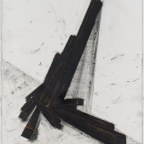The Venet Foundation summer exhibition at Le Muy: Homage to David Tudor
This summer, Bernar Venet pays homage to the American composer David Tudor (1926-1996) in the exhibition space at his home in Le Muy in the South of France, with the support of Wolgang and Anne Titze.
The exhibition offers the chance to discover an artwork that Tudor created in collaboration with the artist Jackie Matisse and the experimental filmmaker Molly Davies. The piece was first presented in 1983 at the Pompidou Centre in Paris.
Tudor was already playing the piano in childhood and became known, as a young man and later still, for his ability to perform complex compositions by such avant-garde composers as John Cage, La Monte Young, Karlheinz Stockhausen, Christian Wolff, Morton Feldman, and Earle Brown. In the 1950s, he helped to introduce pieces notably by Pierre Boulez and John Cage to classical music audiences. For the former, he was the first to perform Boulez’s Piano Sonata No. 2 in the United States, while for the latter, Tudor premiered Cage’s famously silent work 4’33” at the Maverick Concert Hall in Woodstock, New York, in 1952. Tudor and Cage went on to collaborate numerous times until the latter’s death in 1992.
Tudor gradually devoted himself to art and musical composition. Making sound a true raw material in and of itself, he upended the traditional use of instruments and favoured improvisation and electronic music. His works are interdisciplinary, bringing together performance, objets d’art, and installation. The piece called Sea Tails (1983), for example, is a perfect illustration of this decompartmentalization of different practices. The musician collaborated on the project with two others, Henri Matisse’s granddaughter the artist Jackie Matisse (1931-2021), and the American filmmaker and videographer Molly Davies.
In the early 1980s, Jackie Matisse, who was fascinated by kites, turned to her two friends and together the three designed an installation for experimenting with space through sound, movement, colour, and light. The piece involved filming underwater a number of kite tails that measured from 9 to 17 metres long and 5 to 34 centimetres wide. Matisse made the tails in Cadaqués (Spain). What is shown is the movement and our perception of the kite tails according to the density of the water, the current and the light.
The kite tails with their abstract motifs were broken down into three groups (one group of small colourful radiant kite tails; a second of large ones painted on filter paper; and a final group done on canvas in both bright and dark colours). They were plunged in the clear waters of the Bahamas (and hence freed from any discernible background) and filmed. For each group, the best sequence was divided in three. Each of the final work’s three films is made up of six sequences (two for each group of kite tails).
Running around 20 minutes, each film is repeated in a loop and shown on two screens simultaneously (i.e., six monitors set up in two rows of three screens). The soundtracks accompanying the images were created by Tudor from sounds that were recorded during filming (shrimp, coral, splashes, wind, etc.). Repeated indefinitely, the sounds and images create a true visual and audio environment that plays on viewers’ memory and perception. This then is the exceptional experience the Venet Foundation is inviting visitors to share. And as a final grace note to our reading of Sea Tails, Matisse’s kite tails are on display in the exhibition space, prolonging the experience of being immersed in colour and light begun in the film.
David Tudor’s work has been seen in the most prestigious international institutions, including the MoMA, New York; the Pompidou Centre, Paris; at the Lyon, the Lyon Biennial; and recently at the Museum of Modern Art in Salzburg.







